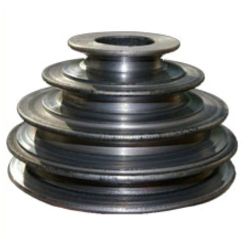Cone Pulley: Difference between revisions
From DT Online
mNo edit summary |
(Added Template) |
||
| Line 1: | Line 1: | ||
[[File:ConePulley.jpg|right| | [[File:ConePulley.jpg|right|250px]] | ||
__TOC__ | |||
=====Description===== | |||
Many machines use '''Cone Pulleys''' to enable the same driver motor to produce different output speeds - e.g. as in a drilling machine. | |||
=====Features and Applications===== | |||
Two '''Cone Pulleys''' are arranged such that the large diameter of one is connected to the small diameter of the other. In this way, a single size drive belt can be moved from one pair of pulleys to another to change speeds. | |||
{{Pulleys Buyers Guide}} | |||
[[Category:Primary]] | [[Category:Primary]] | ||
[[Category:Secondary]] | [[Category:Secondary]] | ||
[[Category:Pulleys]] | [[Category:Pulleys]] | ||
Revision as of 19:00, 3 August 2016
Description
Many machines use Cone Pulleys to enable the same driver motor to produce different output speeds - e.g. as in a drilling machine.
Features and Applications
Two Cone Pulleys are arranged such that the large diameter of one is connected to the small diameter of the other. In this way, a single size drive belt can be moved from one pair of pulleys to another to change speeds.
 |
 |
 |
 |
 |
 |
 |
 |
 |
| Round Plastic Pulley & Belt Kit |
Plastic Belt Pulley |
V Belt Drives |
V Belt Pulleys |
V-Belt Cone Pulley |
Sewing Machine Belt |
Flat Drive Belts |
Toothed Drive Belts |
Ribbed Drive Belts |
